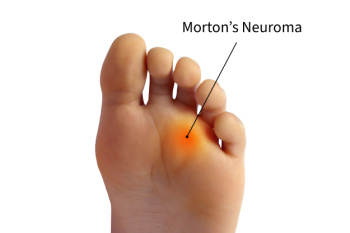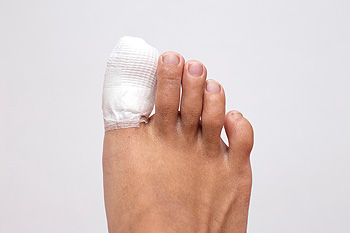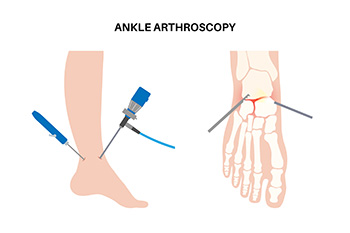Items filtered by date: March 2025
Let the Expert Treat Your Ingrown Toenails
Explaining Rocker Bottom Foot in Babies

Congenital vertical talus, or rocker bottom foot, is a rare condition that affects foot structure from birth. This deformity occurs when the talus bone is improperly positioned, causing the foot to curve abnormally and point upward. The arch appears excessively convex, and the sole may have a rounded shape, making it difficult for your baby’s foot to bear weight properly. Unlike flexible flatfoot seen in newborns, congenital vertical talus leads to stiffness and instability that often requires medical intervention. It is frequently linked to neuromuscular or genetic disorders, and, in some cases, improper positioning in the womb may contribute to its development. A diagnosis is made through a physical examination and confirmed with X-rays, which reveal a misaligned talonavicular joint. While casting may be attempted in early infancy to improve alignment, surgery may be required to reposition the bones and restore function. A podiatrist can assess the condition, discuss treatment options, and provide extended follow-up care. If your baby has a congenital foot deformity, it is suggested that you schedule an appointment with a podiatrist for an exam, diagnosis, and treatment options.
Congenital foot problems require immediate attention to avoid future complications. If you have any concerns, contact Susan Yeager, DPM of Yeager Foot and Ankle Center. Our doctor can provide the care you need to keep you pain-free and on your feet.
Congenital foot problems are deformities affecting the feet, toes, and/or ankles that children are born with. Some of these conditions have a genetic cause while others just happen. Some specific foot ailments that children may be born with include clubfeet, polydactyly/macrodactyly, and cleft foot. There are several other foot anomalies that can occur congenitally. What all of these conditions have in common is that a child may experience difficulty walking or performing everyday activities, as well as trouble finding footwear that fits their foot deformity. Some of these conditions are more serious than others. Consulting with a podiatrist as early as possible will help in properly diagnosing a child’s foot condition while getting the necessary treatment underway.
What are Causes of Congenital Foot Problem?
A congenital foot problem is one that happens to a child at birth. These conditions can be caused by a genetic predisposition, developmental or positional abnormalities during gestation, or with no known cause.
What are Symptoms of Congenital Foot Problems?
Symptoms vary by the congenital condition. Symptoms may consist of the following:
- Clubfoot, where tendons are shortened, bones are shaped differently, and the Achilles tendon is tight, causing the foot to point in and down. It is also possible for the soles of the feet to face each other.
- Polydactyly, which usually consists of a nubbin or small lump of tissue without a bone, a toe that is partially formed but has no joints, or an extra toe.
- Vertical talus, where the talus bone forms in the wrong position causing other bones in the foot to line up improperly, the front of the foot to point up, and the bottom of the foot to stiffen, with no arch, and to curve out.
- Tarsal coalition, when there is an abnormal connection of two or more bones in the foot leading to severe, rigid flatfoot.
- Cleft foot, where there are missing toes, a V-shaped cleft, and other anatomical differences.
- Macrodactyly, when the toes are abnormally large due to overgrowth of the underlying bone or soft tissue.
Treatment and Prevention
While there is nothing one can do to prevent congenital foot problems, raising awareness and receiving neonatal screenings are important. Early detection by taking your child to a podiatrist leads to the best outcome possible.
If you have any questions, please feel free to contact our office located in Redding, CA . We offer the newest diagnostic and treatment technologies for all your foot care needs.
Signs of Morton’s Neuroma

Morton's neuroma is a painful foot condition that typically affects the nerves between the third and fourth toes. It occurs when the tissue surrounding a nerve thickens, causing compression and irritation. Common symptoms include a sharp, burning pain in the ball of the foot, a feeling of something being stuck in your shoe, numbness, or tingling. The pain often worsens while walking or wearing tight shoes. The primary causes of Morton's neuroma include repetitive pressure on the foot, wearing high heels or tight footwear, and certain foot deformities like flat feet. Individuals who participate in high-impact sports or activities may also be more prone to developing a Morton’s neuroma. A podiatrist can help diagnose Morton's neuroma through a physical exam, imaging tests, and a review of your medical history. Treatment options include changes in footwear, orthotic inserts, corticosteroid injections, or surgery, in severe cases. If you are experiencing this type of pain, it is suggested that you schedule an appointment with a podiatrist who can accurately diagnose and treat Morton's neuroma.
Morton’s neuroma is a very uncomfortable condition to live with. If you think you have Morton’s neuroma, contact Susan Yeager, DPM of Yeager Foot and Ankle Center. Our doctor will attend to all of your foot care needs and answer any of your related questions.
Morton’s Neuroma
Morton's neuroma is a painful foot condition that commonly affects the areas between the second and third or third and fourth toe, although other areas of the foot are also susceptible. Morton’s neuroma is caused by an inflamed nerve in the foot that is being squeezed and aggravated by surrounding bones.
What Increases the Chances of Having Morton’s Neuroma?
- Ill-fitting high heels or shoes that add pressure to the toe or foot
- Jogging, running or any sport that involves constant impact to the foot
- Flat feet, bunions, and any other foot deformities
Morton’s neuroma is a very treatable condition. Orthotics and shoe inserts can often be used to alleviate the pain on the forefront of the feet. In more severe cases, corticosteroids can also be prescribed. In order to figure out the best treatment for your neuroma, it’s recommended to seek the care of a podiatrist who can diagnose your condition and provide different treatment options.
If you have any questions, please feel free to contact our office located in Redding, CA . We offer the newest diagnostic and treatment technologies for all your foot care needs.
Broken Versus Jammed Toe

A broken toe occurs when one or more of the toe bones fracture due to trauma or excessive pressure. It can result from dropping a heavy object on the foot, stubbing the toe with force, or experiencing a direct impact during physical activity. A jammed toe, on the other hand, happens when the toe is forcefully bent or compressed, causing soft tissue injury rather than a fracture. Symptoms of a broken toe include severe pain, swelling, bruising, difficulty walking, and possible deformity. A jammed toe usually causes pain, stiffness, mild swelling, and temporary discomfort but does not result in a visible deformity. While both conditions can be painful, a broken toe may require medical evaluation and immobilization. If you have toe pain that may indicate a broken toe, it is suggested that you consult a podiatrist who can offer you appropriate treatment solutions.
Toe pain can disrupt your daily activities. If you have any concerns, contact Susan Yeager, DPM of Yeager Foot and Ankle Center. Our doctor can provide the care you need to keep you pain-free and on your feet.
What Causes Toe Pain?
Most severe toe pain is caused due to a sports injury, trauma from dropping something heavy on the toe, or bumping into something rigid. Other problems can develop over time for various reasons.
Toe pain can be caused by one or more ailments. The most common include:
- Trauma
- Sports injury
- Wearing shoes that are too tight
- Arthritis
- Gout
- Corns and calluses
- Hammertoe
- Bunions
- Blisters
- Ingrown toenails
- Sprains
- Fractures (broken bones)
- Dislocations
When to See a Podiatrist
- Severe pain
- Persistent pain that lasts more than a week
- Signs of infection
- Continued swelling
- Pain that prevents walking
Diagnosis
In many cases the cause of toe pain is obvious, but in others, a podiatrist may want to use more advanced methods to determine the problem. These can range from simple visual inspections and sensation tests to X-rays and MRI scans. Prior medical history, family medical history, and any recent physical traumatic events will all be taken into consideration for a proper diagnosis.
Treatment
Treatments for toe pain and injuries vary and may include shoe inserts, padding, taping, medicines, injections, and in some cases, surgery. If you believe that you have broken a toe, please see a podiatrist as soon as possible.
If you have any questions please contact our office located in Redding, CA . We offer the newest diagnostic and treatment technologies for all your foot and ankle needs.
Arthroscopic Surgery for Ankle Repair

Arthroscopic ankle surgery is a minimally invasive procedure that allows a podiatrist to diagnose and repair damaged tissues in the ankle joint. Using a small camera called an arthroscope, the podiatrist can assess the condition of bones, cartilage, ligaments, and tendons through small incisions. This method is commonly used to treat ligament tears, loose bone or cartilage fragments, and scar tissue that may be causing pain or limiting movement. Ankle arthroscopy can also help reduce discomfort caused by arthritis or impingement, where swollen tissues restrict joint motion. The procedure involves inserting surgical instruments through additional small incisions to repair or remove damaged structures. Compared to open surgery, arthroscopy generally results in less pain and a shorter recovery time. However, healing can vary depending on the severity of the damage and the extent of the repair. A podiatrist can evaluate whether arthroscopic ankle surgery is appropriate and provide guidance on the recovery process. If you would like more information about arthroscopic ankle repair, it is suggested that you schedule an appointment with a podiatrist for an exam and treatment options.
Ankle pain can be caused by a number of problems and may be potentially serious. If you have ankle pain, consult with Susan Yeager, DPM from Yeager Foot and Ankle Center. Our doctor will assess your condition and provide you with quality foot and ankle treatment.
Ankle pain is any condition that causes pain in the ankle. Due to the fact that the ankle consists of tendons, muscles, bones, and ligaments, ankle pain can come from a number of different conditions.
Causes
The most common causes of ankle pain include:
- Types of arthritis (rheumatoid, osteoarthritis, and gout)
- Ankle sprains
- Broken ankles
- Achilles tendonitis
- Achilles tendon rupture
- Stress fractures
- Bursitis
- Tarsal tunnel syndrome
- Plantar fasciitis
Symptoms
Symptoms of ankle injury vary based upon the condition. Pain may include general pain and discomfort, swelling, aching, redness, bruising, burning or stabbing sensations, and/or loss of sensation.
Diagnosis
Due to the wide variety of potential causes of ankle pain, podiatrists will utilize a number of different methods to properly diagnose ankle pain. This can include asking for personal and family medical histories and of any recent injuries. Further diagnosis may include sensation tests, a physical examination, and potentially x-rays or other imaging tests.
Treatment
Just as the range of causes varies widely, so do treatments. Some more common treatments are rest, ice packs, keeping pressure off the foot, orthotics and braces, medication for inflammation and pain, and surgery.
If you have any questions please feel free to contact our office located in Redding, CA . We offer the newest diagnostic tools and technology to treat your foot and ankle needs.

